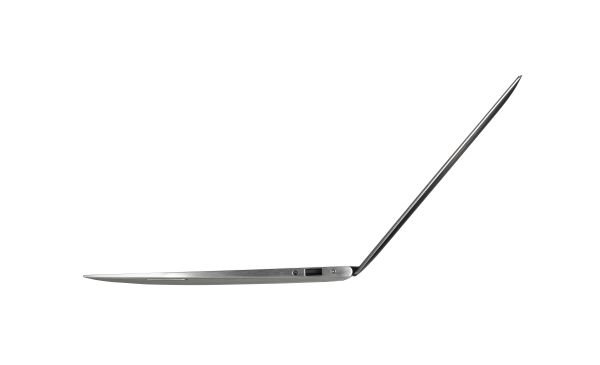The Ultrabook: Meet the New Thin and Light Intel Notebook
by Anand Lal Shimpi on May 31, 2011 12:01 AM EST- Posted in
- Laptops
- CPUs
- Intel
- Atom
- Haswell
- Computex 2011
- Trade Shows
- Ultrabook
Meet the Ultrabook
The Ultrabook is a multi-year evolution from Intel's perspective. It's going to begin as a pilot program with some Sandy Bridge systems this year, it'll ramp heavily next year with Ivy Bridge and be mainstream by the time Haswell arrives in 2013.
What is an Ultrabook? It's basically a thin and light notebook that uses solid state storage in some form, has some additional security features and is available at mainstream price points. This isn't a new platform, there's no Centrino-like certification process, but Intel has trademarked the name so you won't see things that aren't Ultrabooks being called Ultrabooks (unfortunately this also likely means that you won't see any AMD notebooks being labeled as such either).
The first requirement of an Ultrabook is that it's ultra-thin. In Intel's eyes this means less than 0.8" (20.32mm) which is thinner than anything Apple offers in the MacBook Pro line (0.95").
The second requirement is that the system needs to be ultra responsive, either through the use of an SSD or SSD caching. Intel was quick to point out that an Ultrabook doesn't have to use an Intel SSD, it just needs to have SSD-like response time.

Here's where the requirements start getting vague. Intel asserted that Ultrabooks need to be secure. Today that security comes by way of Sandy Bridge, which offers Intel's Identity Protection Technology (IPT) - basically a unique hardware token embedded in the SNB CPU. You tell an application that your computer is secure, and going forward it uses the presence of that unique token as a form of authentication.
Ivy Bridge will add some additional security features (on-package digital random number generator, and higher level execution protection bit) and I'm sure Haswell will go even further. Remember Intel's acquisition of McAfee? I suspect that's going to be a part of this security strategy.
The final requirement is all Ultrabooks must be sold at mainstream price points, which Intel calls sub-$1000.
You'll notice that I haven't mentioned Atom. That's on purpose as Atom will not be driving any of these Ultrabooks. Intel has separate plans for Atom, for use in smartphones and fanless designs which I'll get to in a moment. But Ultrabooks are the future of mainstream notebooks as far as Intel is concerned. A Sandy/Ivy/Haswell based notebook that's less than 0.8-inches thick, has some form of an SSD and is sold for less than $1199 is a-ok by me.
One of Intel's closest partners, ASUS, already introduced the first Ultrabook at Computex: the new UX21. Availability of ASUS' UX Series Ultrabook is slated for Q4 of this year:
Intel estimates that by the end of next year 40% of consumer notebooks will be Ultrabooks. Given the desirable set of features and reasonable price point, I can see that happening.
Always On, Always Connected
Intel views the Ultrabook as a new category of mobile devices, however everything I've described thus far sounds a lot like a thin and light notebook with an SSD inside it. There's a software component to all of this that Intel is promising, starting as early as Sandy Bridge.
Intel wants to bring the instant-on capability of tablets to Ultrabooks. Apple already did some of this with the new MacBook Air. Suspend to NAND allows for a reliable method to quickly hibernate and resume. ASUS is already promising a 2 second resume from sleep time on its new UX Series.
Intel also wants to bring the always on, always connected experience to Ultrabooks. 3G tablets and smartphones currently enjoy this but notebooks have lacked it. When you wake your notebook up from sleep you usually have to wait to download all new emails, receive all new twitter updates, etc... Through a software layer Intel isn't ready to talk about yet, Ultrabooks will be able to pull this data from the cloud while the machine is otherwise asleep. That's the functionality with the first generation of Ultrabooks; the second generation will move to a smartphone-like push model where servers push this data to your Ultrabook. Again, details on how this will all work are basically nonexistant at present but the goal is to take some features from the smartphone/tablet space and add them to a much sleeker, sexier notebook. Hence the name Ultrabook.

















33 Comments
View All Comments
Shadowmaster625 - Wednesday, June 1, 2011 - link
All the reviews I can find are talking about a lot of heat and not very impressive battery life. Specifically, the i5-2537M. I wish Anandtech would do a more comprehensive review of these ultra expensive low power parts. When you comapre a 17W part with a 35W part, is the power consumption really cut in half or are they full of it?tipoo - Wednesday, June 1, 2011 - link
If both systems were under 100% load, it might be cut in half. Otherwise, absolutely not. THe 35w part might finish a task three times quicker and get to idle longer.High John - Sunday, June 26, 2011 - link
Surely the goal is 'ultraportability', which I would primarily evaluate in terms of performance, weight and battery life.Why should it matter if an Ultrabook is more than 20mm thick?